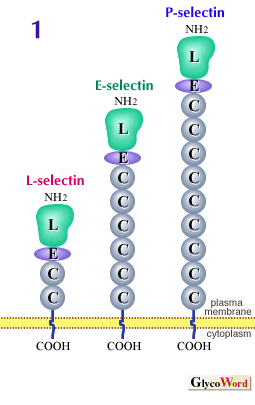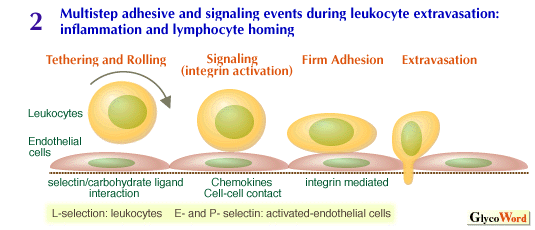| Cell Adhesion Molecules: Selectins |  |
|
 |
Leukocyte extravasation is an important process in self-defense mechanisms at a site of inflammation as well as in lymphocyte homing. It is also important as a process responsible for pathogenesis of inflammatory disorders. Selectins are cell-cell adhesion molecules that are involved in leukocyte-endothelial cell adhesive interaction, which is required for extravasation at target tissue sites. They belong to the C-type (calcium-dependent) lectin family, and a similarity in the domain organization (and homology in amino acid sequence) allows them to be recognized as a family of cell-cell adhesion molecules. They have a single C-type lectin domain (L) at their extracellular amino termini, followed by an epidermal growth factor (EGF)-like domain (E), several complement regulatory domains (C), transmembrane domain and short cytoplasmic tail (Figure 1). | |
|
|  | |
|
|
Three types of selectins have been discovered so far. L-selectins are generally expressed on almost all leukocytes. E-selectins are inducible on vascular endothelium upon stimulation with cytokines due to transcriptional activation. P-selectins were originally found on activated platelets; however, their expression is also induced on activated vascular endothelium. P-selectins are stored as preformed transmembrane proteins in cytoplasmic granules, and they are translocated on cell surface upon stimulation. Selectin-mediated cell adhesion is based on carbohydrate recognition of calcium-dependent lectin. Basically, ligands for L-selectin are found on endothelial cells while ligands for E- and P-selectins are found on leukocytes.
Every selectin has affinity to oligosaccharides with sialyl-Lex or sialyl-Lea determinants, however, the affinity on the level of oligosaccharides is not high. Therefore, the role of carbohydrate presenting molecules that can produce multivalent interaction between carbohydrate chains and the lectin domains is important. As carbohydrate-presenting molecules for L-selectin (1), GlyCAM-1, CD34, Sgp200 and MAdCAM-1 have been discovered. They are sialylated, fucosylated and sulfated mucin-like carbohydrate- presenting molecules that can present clusters of O-linked sugar chains to the lectin domain of L-selectin. Functional importance of sialic acid and sulfate on sugar chains has been directly demonstrated (2). Modification of ligand specificity by sulfation on sugar chains is an interesting subject in the field of glycobiology. In the case of GlyCAM-1, carbohydrate structure containing sulfate-modified sialyl Lex determinant has been reported.
As a ligand for P-selectin, a mucin-like carbohydrate presenting molecule PSGL-1 has been reported. It was originally discovered on neutrophils, but it is now known to be expressed on essentially all types of leukocytes. In the case of PSGL-1, both sulfated tyrosine and carbohydrate chains at the amino terminal region are reported to be required for high affinity binding to P-selectin. It is also reported that L-selectin and E-selectin also bind to PSGL-1. As a carbohydrate-presenting molecule for E-selectin, ESL-1 has been reported. N-linked sugar chains on ESL-1 appeared to be responsible for the ligand activity. Biological function of selectins is recognized as follows (Figure 2). | |
|
 |
|
|
Rapid and transient binding and dissociation between selectin and its ligand make leukocyte slow down at post capillary venules at the site of inflammation or at high endothlial venules in the lymphoid tissue. This process, called tethering or rolling, was originally reported in an in vitro flow chamber experiment in which neutrophil rolling on the surface coated with purified P-selectin were observed using microscopic videometry (3). Basically, leukocytes roll on vascular endothelial cells based on the interaction between selectins and their ligands in vivo. Secondary rolling phenomenon has also been reported in which leukocytes roll on other leukocytes that have already adhered to endothelial cells. This phenomenon is based on the interaction between L-selectin and carbohydrate ligands presented on PSGL-1 on neutrophils.
Leukocytes slow down by rolling, then receive signals. The signals produce signal transduction cascade to activate leukocyte integrins into high affinity state, and then firm adhesion of leukocytes on endothelial cells is established based on the protein-protein interaction between leukocyte integrins and adhesion molecules of the immunoglobulin superfamily (for example, ICAM-1 and VCAM-1). As for the nature of the local signals, the role of chemokines (a type of cytokines) has been proposed. Recent study has also revealed the possibility that direct cell-cell contact, mediated for example by L-selectin or PSGL-1, may be responsible for the cell signaling process. Thus, selectins and their ligands not only contribute to the leukocyte extravasation as cell adhesion molecules but may also play some role in the signaling process. | |
|
|
|
| Yasuyuki Imai (Department of Microbiology,
University of Shizuoka School of Pharmaceutical Sciences) | |
|
|
| References | (1) | Imai, Y et al. J. Cell Biol. 113, 1213-1221, 1991 |
| (2) | Imai, Y et al. Nature 361, 555-557, 1993 |
| (3) | Lawrence, M B Springer, T A. Cell 65, 859-873, 1991 |
| | |
| |
| Mar.15, 1998 |
|
| |
|
|
|
|



